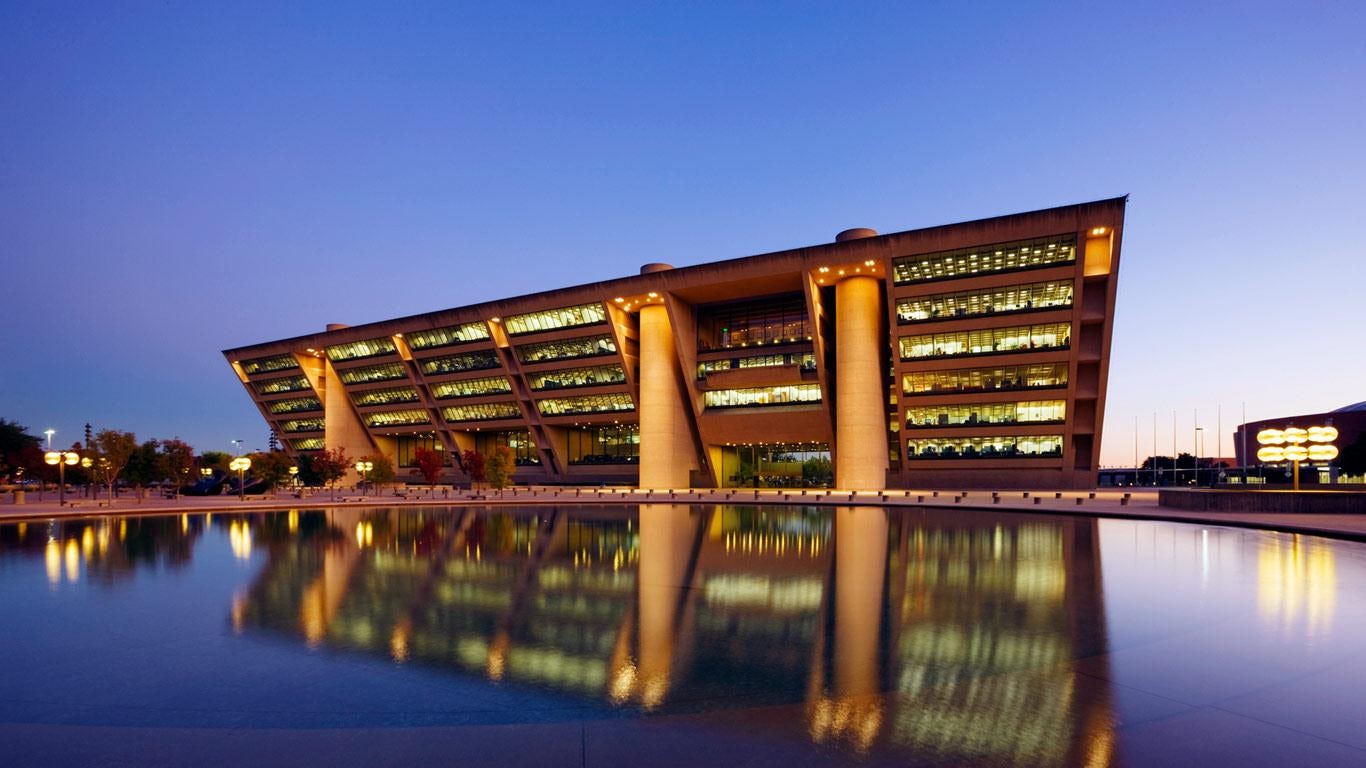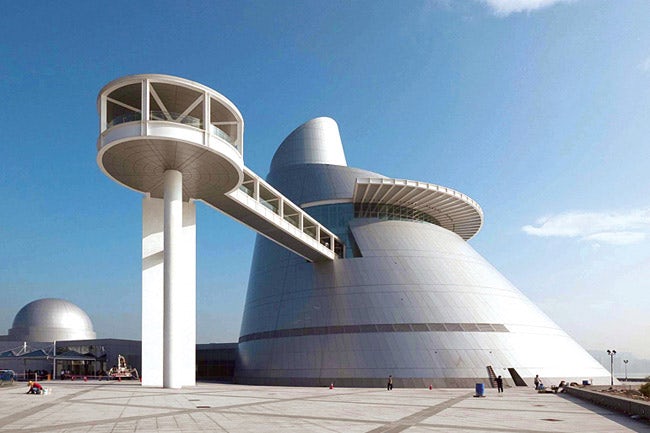He won a Pritzker Prize, has a career spanning seven decades and has designed some of the world’s most iconic buildings. But today, legendary architect I.M. Pei reaches another milestone: turning 100 years old! To celebrate the birthday of one of architecture’s perennial masters of Modernism, we have compiled a list of his best and most renowned buildings across the globe — and with more than 60 projects across four continents, it was not an easy task.
Noted for their rich materiality and understated elegance, Pei’s buildings range from office towers to art museums to civic structures, and his distinct style has evolved over time. From the John F. Kennedy Presidential Library and Museum in Boston to the Museum of Islamic Art in Doha, Qatar, the architect has displayed an incredible ability to respond to varied design briefs and contexts through the decades.
Enjoy this collection of Pei’s most prestigious commissions, and join us as we celebrate a special centenary for one of the most influential figures ever to grace the profession. Happy birthday, I.M. Pei!

Via Haoss Forum
Place Ville-Marie, Montreal, Canada (1962)
Place Ville Marie was one of the first completed buildings by I.M. Pei in partnership with Henry N. Cobb, and transformed the skyline of Montreal — at the time of its completion, it was the third tallest skyscraper on Earth outside the United States. It remains a bold example of the International Style, and cemented Pei and his firm as a key advocate of Modernist architecture.

Luce Memorial Chapel, Taichung, Taiwan (1963)
One of Pei’s most striking buildings, the Luce Memorial Chapel was completed in 1963 and stands as a central landmark of Tunghai University. Originally designed as a multi-planar, wooden structure, the structural system was altered due to seismic concerns. Instead, an elegant lattice of reinforced concrete beams was used to brace each swooping plane of the building, giving the chapel its unique, iconic form.

Via Wally Gobetz on Flickr
Mesa Laboratory(National Center for Atmospheric Research), Boulder, Colo. (1967)
An example of I.M. Pei’s love of blending Modernist and vernacular styles, Mesa Laboratory is famous for its Anasazi-inspired architecture and use of bush-hammered concrete, a material common to the area. Basing the design on the incredible cliff dwellings of Mesa Verde, Pei said he wanted the research center to look “as if it were carved out of the mountain.” The building was named Laboratory of the Year upon opening in 1967.

Via SkyscraperCity
Dallas City Hall, Dallas (1977)
I.M. Pei’s use of an inverted prism for Dallas City Hall was a direct result of the programmatic requirements of the building — much less space was needed for public areas and citizen services than for the governmental offices above. Pei designed the building to act as the civic heart of the city. “When you do a city hall,” he said, “it has to convey an image of the people, and this had to represent the people of Dallas.”

Via National Gallery of Art, Washington, DC
East Building, National Gallery of Art, Washington, D.C. (1978)
Pei’s addition to the National Gallery of Art in Washington, D.C., struck a remarkable contrast with John Russell Pope’s original neoclassical building. Façades of warm-colored stone and a monumental sense of scale were designed to pay homage to the older building, but Pei eschewed ornament and fussy fenestration to form a truly modern wing for this historic institution.

Via Curbed Boston
John F. Kennedy Presidential Library and Museum, Boston (1979)
Following the tragedy of John F. Kennedy’s assassination, a powerful architectural statement was needed for the Presidential Library, one that would stand as a fitting tribute to one of America’s most popular leaders. Pei provided it, composing a striking form from concrete and glass that became an instant icon for Boston. The architect considers this “the most important commission” in his life.

Via I Love Hong Kong
Bank of China Tower, Hong Kong (1989)
Considered one of Hong Kong’s most iconic skyscrapers, I.M. Pei’s Bank of China Tower is a stunning, asymmetrical construction set in the center of the city’s skyline. The 70-story-tall tower anchors Hong Kong’s massive business district and serves as a symbol of the ambitions of the Chinese people and goodwill toward the British colony. The design, a faceted prism clad in reflective glass, was inspired by the growth patterns of a bamboo plant.

Via Wallpaper Abyss
Louvre Pyramid and La Pyramide Inversée, Louvre, Paris, France (1993)
After nearly 25 years of existence, the glass and steel pyramid that serves as the Louvre’s main entrance is one of I.M. Pei’s seminal works. Not only was it a practical design, alleviating congestion in the galleries and allowing the museum to expand its collection, this landmark project has become synonymous with both the museum and the city of Paris. The crystalline structure, a perfect juxtaposition against the museum’s French Renaissance style, matches the proportions of the famous Pyramids of Giza. Standing 22 meters high (72 feet) with 30-meter (98-meter) sloping sides, the pyramid invites visitors underground to explore this historic museum.

Via HBO.com
Rock and Roll Hall of Fame, Cleveland, Ohio (1995)
A day after opening in 1995, Herbert Muschamp wrote that the Rock and Roll Hall of Fame featured “saucy geometric forms [that] cantilevered out from the middle of a six-story tower,” forming a “swivel-hipped apparition in metal and glass.” Essentially equating the architecture to the style and edge of Elvis Presley, Muschamp saw the 150,000-square-foot design as worthy of its integral function: hosting a museum dedicated to the preservation and energy of American rock history. I.M. Pei’s vision for the seminal building featured a tetrahedral glass tent posed behind the 165-foot-high tower that connects to the theater space jutting out over Lake Erie. The interior includes a soaring, sun-filled atrium and 55,000 square feet of underground museum space.

Via koolbe on Flickr
Miho Museum, Shiga, Japan (1997)
Japanese textile heiress Mihoko Koyama commissioned I.M. Pei to design this incredible museum set within a hilly and forested landscape. Calling the project his “Shangri-La,” it housed the private collection of Koyama’s Asian and Western antiques. One-third of the building was designed underground and carved out of rock. The roof features large glass and steel trusses on the interior, while the walls and floors of the facility are covered in beige limestone similar to the Louvre in Paris.

Via iDesignArch.com
Museum of Islamic Art, Doha, Qatar (2008)
The 376,740-square-foot Museum of Islamic Art is set off the coast of Doha’s Corniche, creating its own private island dedicated to the collection and preservation of Islamic art. The geometrical building rises from the sea in a singular, stepped construction that features a soaring, domed atrium. Built from cream-colored limestone, granite and stainless steel, the museum includes a five-story main building and a two-story education facility. The north façade of the museum features a glass curtain wall that shows expansive views of the Gulf and West Bay area of Doha.

Via Into the Fashion
Macao Science Center (in association with Pei Partnership Architects), Macau (2009)
I.M. Pei’s 23,000-square-meter [248,000-square-foot] Macao Science Center is a shiny, aluminum-clad cultural and educational facility set on the shore of Macao, opposite Hong Kong. When completed in 2009, its asymmetrical, conical shape became instantly recognizable as a symbol of Macao. Its distinctive design includes a gleaming spiral staircase, towering atrium and a 150-seat planetarium. The museum houses interactive exhibition galleries, conference facilities and education spaces.









